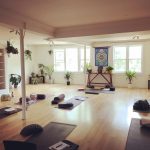Savasana

Savasana is one of the most difficult poses in yoga. Not because of any strenuous twists or bends, but because it requires the body to become fully relaxed. Savasana is performed at the end of a yoga practice and can serve as a starting point for meditation. The traditional Savasana pose is done while lying on the back. The practitioner lies flat on their back with arms and legs spread out. The palms should face up and the feet relaxed with the toes lying towards the outside of the yoga mat and the heels lying towards the center of the yoga mat. This is where the body comes to the full relaxation and the physical and meditative aspects of yoga intertwine into pure bliss.
Savasana can help relieve mild depression, high blood pressure, headaches, fatigue, and insomnia. However, these benefits can only be achieved when the mind and body are both completely relaxed. It’s easy to relax the mind and body completely when asleep, but can pose to be a difficult task when awake. The body tends to come to rest a lot easier than the mind. The mind tends to wander thinking about when practice is going to be over or what’s for dinner later that night. Savasana requires conscious surrender. It requires us to stop trying to keep up with the moving world and find peace in the now. It reboots the body and results in a better functioning mind and body. Here are some steps that can be taken to be more successful in Savasana.

Be comfortable. Give the body an environment that it can become completely relaxed in. Bolsters, pillows and blankets can aid in creating a more relaxing environment. A pillow or towel can even be placed over the eyes to help get away from distractions. The more you surrender, the more beneficial this pose will be. If you are a beginner check out this video that demonstrates how to relax.
Take a final breath. Take a deep and long cleansing breath right when you start Savasana. This helps to relax the body further and signals the body to slowly release breath control. A cleansing breath sends a message to the nervous system to relax and just be still.
Locate tension. Mentally go over your body from top to bottom and locate where you are holding tension. Once located, acknowledge the tension and release it. Tension can be released much easier when it is first acknowledged.
Take notice. Take notice in how long you are able to hold Savasana and the difference you feel. Your mind and body feels different when full relaxation is completed than it does when the mind was racing during the pose. Noticing this difference will help for Savasana to be successful more often than not.
It is important to remember that Savasana is a time to rest, not to sleep. Some people have a tendency to fall asleep during this pose, but this means that they will not reap the full benefits. This pose must be taken awake to train the body and mind to come to full and utter relaxation. For more info about Savasana and its benefits visit this blog.






